new posts in all blogs
Viewing: Blog Posts Tagged with: casino, Most Recent at Top [Help]
Results 1 - 16 of 16
How to use this Page
You are viewing the most recent posts tagged with the words: casino in the JacketFlap blog reader. What is a tag? Think of a tag as a keyword or category label. Tags can both help you find posts on JacketFlap.com as well as provide an easy way for you to "remember" and classify posts for later recall. Try adding a tag yourself by clicking "Add a tag" below a post's header. Scroll down through the list of Recent Posts in the left column and click on a post title that sounds interesting. You can view all posts from a specific blog by clicking the Blog name in the right column, or you can click a 'More Posts from this Blog' link in any individual post.

By:
Betsy Bird,
on 9/9/2015
Blog:
A Fuse #8 Production
(
Login to Add to MyJacketFlap)
JacketFlap tags:
2015 Sibert Award contender,
Best Books of 2015,
Reviews 2015,
2015 reviews,
2015 nonfiction,
2015 nonfiction picture books,
2015 biography,
Reviews,
nonfiction,
Don Tate,
Chris Barton,
nonfiction picture books,
biographies,
Best Books,
Eerdmans Books for Young Readers,
picture book biographies,
Add a tag
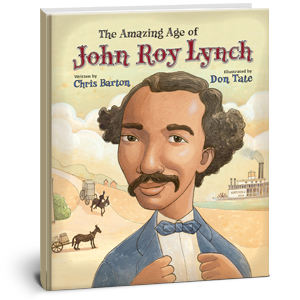 The Amazing Age of John Roy Lynch
The Amazing Age of John Roy Lynch
By Chris Barton
Illustrated by Don Tate
Eerdmans Books for Young Readers
$17.00
ISBN: 978-0-8028-5379-0
Ages 4-8
On shelves now
“It’s the story of a guy who in ten years went from teenage field slave to U.S. Congressman.” Come again? That’s the pitch author Chris Barton pulled out when he wanted to describe this story to others. You know, children’s book biographies can be very easy as long as you cover the same fifteen to twenty people over and over again. And you could forgive a child for never imagining that there were remarkable people out there beyond Einstein, Tubman, Jefferson, and Sacajawea. People with stories that aren’t just unknown to kids but to whole swaths of adults as well. So I always get kind of excited when I see someone new out there. And I get extra especially excited when the author involved is Chris Barton. Here’s a guy who performed original research to write a picture book biography of the guys who invented Day-Glo colors (The Day-Glo Brothers) so you know you’re in safe hands. The inclusion of illustrator Don Tate was not something I would have thought up myself, but by gum it turns out that he’s the best possible artist for this story! Tackling what turns out to be a near impossible task (explaining Reconstruction to kids without plunging them into the depths of despair), this keen duo present a book that reads so well you’re left wondering not just how they managed to pull it off, but if anyone else can learn something from their technique.
From birth until the age of sixteen John Roy Lynch was a slave. The son of an overseer who died before he could free his family, John Roy began life as a house slave but was sent to the fields when his high-strung mistress made him the brunt of her wrath. Not long after, The Civil War broke out and John Roy bought himself a ride to Natchez and got a job. He started out as a waiter than moved on to pantryman, photographer, and in time orator and even Justice of the Peace. Then, at twenty-four years of age, John Roy Lynch was elected to the Mississippi House of Representatives where he served as Speaker of the House. The year was 1869, and these changes did not pass without incident. Soon an angry white South took its fury out on its African American population and the strides that had been made were rescinded violently. John Roy Lynch would serve out two terms before leaving office. He lived to a ripe old age, dying at last in 1939. A Historical Note, Timeline, Author’s Note, Illustrator’s Note, Bibliography of books “For Further Reading”, and map of John’s journey and the Reconstructed United States circa 1870 appear at the end.
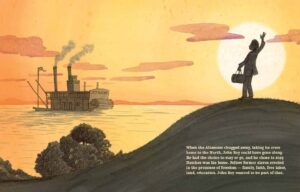 How do you write a book for children about a time when things were starting to look good and then plummeted into bad for a very very long time? I think kids have this perception (oh heck, a bunch of adults too) that we live in the best of all possible worlds. For example, there’s a children’s book series called Infinity Ring where the basic premise is that bad guys have gone and changed history and now it’s up to our heroes to put everything back because, obviously, this world we live in right now is the best. Simple, right? Their first adventure is to make sure Columbus “discovers” America so . . . yup. Too often books for kids reinforce the belief that everything that has happened has to have happened that way. So when we consider how few books really discuss Reconstruction, it’s not exactly surprising. Children’s books are distinguished, in part, by their capacity to inspire hope. What is there about Reconstruction to cause hope at all? And how do you teach that to kids?
How do you write a book for children about a time when things were starting to look good and then plummeted into bad for a very very long time? I think kids have this perception (oh heck, a bunch of adults too) that we live in the best of all possible worlds. For example, there’s a children’s book series called Infinity Ring where the basic premise is that bad guys have gone and changed history and now it’s up to our heroes to put everything back because, obviously, this world we live in right now is the best. Simple, right? Their first adventure is to make sure Columbus “discovers” America so . . . yup. Too often books for kids reinforce the belief that everything that has happened has to have happened that way. So when we consider how few books really discuss Reconstruction, it’s not exactly surprising. Children’s books are distinguished, in part, by their capacity to inspire hope. What is there about Reconstruction to cause hope at all? And how do you teach that to kids?
Barton’s solution is clever because rather than write a book about Reconstruction specifically, he’s found a historical figure that guides the child reader effortlessly through the time period. Lynch’s life is perfect for every step of this process. From slavery to a freedom that felt like slavery. Then slow independence, an education, public speaking, new responsibilities, political success, two Congressional terms, and then an entirely different life after that (serving in the Spanish-American War as a major, moving to Chicago, dying). Barton shows his rise and then follows his election with a two-page spread of KKK mayhem, explaining that the strides made were taken back “In a way, the Civil War wasn’t really over. The battling had not stopped.” And after quoting a speech where Lynch proclaims that America will never be free until “every man, woman, and child can feel and know that his, her, and their rights are fully protected by the strong arm of a generous and grateful Republic,” Barton follows it up with, “If John Roy Lynch had lived a hundred years (and he nearly did), he would not have seen that come to pass.” Barton guides young readers to the brink of the good and then explains the bad, giving context to just how long the worst of it continued. He also leaves it up to them to determine if Lynch’s dream has come to fruition or not (classroom debate time!).
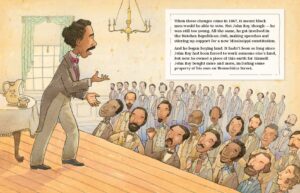 And he plays fair. These days I read nonfiction picture books with my teeth clenched. Why? Because I’ve started holding them to high standards (doggone it). And there are so many moments in this book that could have been done incorrectly. Heck, the first image you see when you open it up is of John Roy Lynch’s family, his white overseer father holding his black wife tenderly as their kids stand by. I saw it and immediately wondered how we could believe that Lynch’s parents ever cared for one another. Yet a turn of the page and Barton not only puts Patrick Lynch’s profession into context (“while he may have loved these slaves, he most likely took the whip to others”) but provides information on how he attempted to buy his wife and children. Later there is some dialogue in the book, as when Lynch’s owner at one point joshes with him at the table and John Roy makes the mistake of offering an honest answer. Yet the dialogue is clearly taken from a text somewhere, not made up to fit the context of the book. I loathe faux dialogue, mostly because it’s entirely unnecessary. Barton shows clearly that one need never rely upon it to make a book exemplary.
And he plays fair. These days I read nonfiction picture books with my teeth clenched. Why? Because I’ve started holding them to high standards (doggone it). And there are so many moments in this book that could have been done incorrectly. Heck, the first image you see when you open it up is of John Roy Lynch’s family, his white overseer father holding his black wife tenderly as their kids stand by. I saw it and immediately wondered how we could believe that Lynch’s parents ever cared for one another. Yet a turn of the page and Barton not only puts Patrick Lynch’s profession into context (“while he may have loved these slaves, he most likely took the whip to others”) but provides information on how he attempted to buy his wife and children. Later there is some dialogue in the book, as when Lynch’s owner at one point joshes with him at the table and John Roy makes the mistake of offering an honest answer. Yet the dialogue is clearly taken from a text somewhere, not made up to fit the context of the book. I loathe faux dialogue, mostly because it’s entirely unnecessary. Barton shows clearly that one need never rely upon it to make a book exemplary.
Finally, you just have to stand in awe of Barton’s storytelling. Not making up dialogue is one thing. Drawing a natural link between a life and the world in which that life lived is another entirely. Take that moment when John Roy answers his master honestly. He’s banished to hard labor on a plantation after his master’s wife gets angry. Then Barton writes, “She was not alone in rage and spite and hurt and lashing out. The leaders of the South reacted the same way to the election of a president – Abraham Lincoln – who was opposed to slavery.” See how he did that? He managed to bring the greater context of the times in line with John Roy’s personal story. Many is the clunky picture book biography that shoehorns in the era or, worse, fails to mention it at all. I much preferred Barton’s methods. There’s an elegance to them.
I’ve been aware of Don Tate for a number of years. No slouch, the guy’s illustrated numerous children’s books, and even wrote (but didn’t illustrate) one that earned him an Ezra Jack Keats New Writer Honor Award (It Jes’ Happened: When Bill Traylor Started to Draw). His is a seemingly simple style. I wouldn’t exactly call it cartoony, but it is kid friendly. Clear lines. Open faces. His watercolors go for honesty and clarity and do not come across as particularly evocative. But I hadn’t ever seen the man do nonfiction, I’ll admit. And while it probably took me a page or two to understand, once I realized why Don Tate was the perfect artist for “John Roy Lynch” it all clicked into place. You see, books about slavery for kids usually follow a prescribed pattern. Some of them go for hyperrealism. Books with art by James Ransome, Eric Velasquez, Floyd Cooper, or E.B Lewis all adhere closely to this style. Then there are the books that are a little more abstract. Books with art by R. Gregory Christie, for example, traipse closely to art worthy of Jacob Lawrence. And Shane W. Evans has a style that’s significantly artistic. A more cartoony style is often considered too simplistic for the heavy subject matter or, worse, disrespectful. But what are we really talking about here? If the book is going to speak honestly about what slavery really was, the subjugation of whole generations of people, then art that hews closely to the truth is going to be too horrific for kids. You need someone who can cushion the blow, to a certain extent. It isn’t that Tate is shying away from the horrors. But when he draws it it loses some of its worst terrors. There is one two-page spread in this book that depicts angry whites whipping and lynching their black neighbors.  It’s not shown as an exact moment in time, but rather a composite of events that would have happened then. And there’s something about Tate’s style that makes it manageable. The whip has not yet fallen and the noose has not yet been placed around a neck, but the angry mobs are there and you know that the worst is imminent. Most interesting to me too is that far in the background a white woman and her two children just stand there, neither approving nor condemning the action. I think you could get a very good conversation out of kids about this family. What are they feeling? Whose side are they on? Why don’t they do something?
It’s not shown as an exact moment in time, but rather a composite of events that would have happened then. And there’s something about Tate’s style that makes it manageable. The whip has not yet fallen and the noose has not yet been placed around a neck, but the angry mobs are there and you know that the worst is imminent. Most interesting to me too is that far in the background a white woman and her two children just stand there, neither approving nor condemning the action. I think you could get a very good conversation out of kids about this family. What are they feeling? Whose side are they on? Why don’t they do something?
And Tate has adapted his style, you can see. Compare the heads and faces in this book to those in one of his earlier books like, Ron’s Big Mission by Rose Blue, in this one he modifies the heads, making them a bit smaller, in proportion with the rest of the body. I was particularly interested in how he did faces as well. If you watch Lynch’s face as a child and teen it’s significant how he keeps is features blank in the presence of white people. Not expressionless, but devoid of telltale thoughts. As a character, the first time he smiles is when he finally has a job he can be paid for. With its silhouetted moments, good design sense, tapered but not muted color palette, and attention to detail, Mr. Tate puts his all into what is by far his most sophisticated work to date.
This year rage erupted over the fact that the Confederate flag continues to fly over the South Carolina statehouse grounds. To imagine that the story Barton relates here does not have immediate applications to contemporary news is facile. As he mentions in his Author’s Note, “I think it’s a shame how little we question why the civil rights movement in this country occurred a full century following the emancipation of the slaves rather than immediately afterward.” So as an author he found an inspiring, if too little known, story of a man who did something absolutely astounding. A story that every schoolchild should know. If there’s any justice in the universe, after reading this book they will. Reconstruction done right. Nonfiction done well.
On shelves now.
Source: Final copy sent from publisher for review.
Like This? Then Try:
Professional Reviews:
Misc: For you, m’dear? An educator’s guide.
Videos: A book trailer and everything!

By:
Sue Morris @ KidLitReviews,
on 6/1/2015
Blog:
Kid Lit Reviews
(
Login to Add to MyJacketFlap)
JacketFlap tags:
Crazy,
high school angst,
Eerdmans Books for Young Readers,
mental illness,
Debut Author,
bipolar disorder,
powerful,
Book Excerpt,
emotional,
5stars,
Library Donated Books,
1960s JFK assassination,
Linda Vigen Phillips,
Middle Grade,
Favorites,
Add a tag
Today’s review is a bit different from the usual fare here on Kid Lit Reviews. I received a young adult book last year, which I do not review, because I firmly believe YA does not mix well with picture books and middle grade fare. I set it aside. Last night, needing a break from reading kid’s books and packing boxes, I picked up that book, simply titled Crazy. Crazy is Linda Vigen Phillips debut into children’s lit. Written in verse, the story is a fast read. The story shines a light on mental illness and, though set in the 1960s, is every bit as relevant today as it was then. Crazy moved me and I hope it moves you.
 Crazy
Crazy
Written by Linda Vigen Phillips
Eerdmans Books for Young Readers 10/06/2014
978-0-8028-5437-7
314 pages Age 12+
A Junior Library Guild Selection for 2014
“Laura is a typical fifteen-year-old growing up in the 1960s, navigating her way through classes, friendships, and even a new romance. But she’s carrying around a secret: her mother is suffering from a mental illness. No one in Laura’s family will talk about her mother’s past hospitalizations or increasingly erratic behavior, and Laura is confused and frightened. Laura finds some solace in art, but when her mother, also an artist, suffers a breakdown, Laura fears that she will follow in her mother’s footsteps. Left without a refuge, can she find the courage to face what scares her most?” [book cover]
Review
15-year-old Laura’s mother suffers from bipolar disorder and the family suffers right along with her, as most often happens. The author took parts of her own life, apparently having a mother who also suffered from mental illness. In the sixties, where the story takes place, mental illness carried much stigma so families kept this very secret. A lot of effort went into hiding the ailment from others. Kids never brought friends home to play or for sleepovers. If the family member was admitted to a psychiatric hospital, the family’s secret keeping went into high alert.
Now this may sound crazy in itself, but people outside the family secret did treat kids and adults with a mentally ill family member differently—poorly, often as if the craziness could rub off the family and onto them. Many people did not consider mental illness a medical disorder. Instead, mental illness was a problem of attitude, disposition, and a weakness of the will. Thus, mentally ill people could cure themselves by changing their attitude and their disposition by just acting normal. “If they would just do this or do that, they would be fine in no time,” was the basic attitude of most people.
The mother was a brilliant artist when younger, but gave it up. Laura encourages her mother to paint again, thinking it might help her mother regain her sense of self and thus act more normal. Instead, her mother has a “nervous breakdown.” Now Laura blames herself because she encouraged her mother to paint and, in her mind, the act of painting again caused her mother to collapse. Being a gifted artist in her own right, Laura is terrified that she will tumble into the same black hole her mother has. At one point, Laura even believes she is on her way, and in great fear and despair, refuses to paint, despite a contest deadline looming near.
NERVOUS BREAKDOWN
“If you’ve ever been there
when a lightbulb gets real bright
just before it blows out,
then you know what it was like
around here when things got extremely crazy,
right before they shipped Mama off
to the nut house.
“It’s all my fault
for suggesting
she take up painting again.
That’s what she was doing
that day I came home
to such a mess.
She was trying to paint on canvas,
not ceramics,
and maybe,
well, maybe she just forgot
how to do it
and it frustrated her real bad.
I could see she was beside herself
with frustration.
“I never should have suggested it.
“Maybe that’s why she put her hand
on the hot stove last night
and didn’t even smell
the burning flesh.
Now on top of her craziness
she has a bandaged hand.”
The problem in the sixties, as it was in the fifties, and every decade past, was a lack of information. Even today, though much enlightened, some still attach a stigma to mental illness. Books like Crazy help change these views by looking to the next generation. Laura, having been kept in the dark by her family (Laura is not old enough to understand), knows little about her mother’s illness. She understands mom is crazy, as she lives with the craziness each day. Laura watches her mother sit in a chair all day, staring at nothing in particular and worrying about everything (JFK’s assassination occurs), then watches her mother in crazed action, with energy that overflows and keeps her moving for days.
Laura gives up her own artistic talent to maintain her sanity, but it does not work. Laura feels herself falling deeper into a hole she cannot comprehend. Despite asking what is specifically going on with her mother, no one will explain. Not understanding, Laura’s mind works herself into her own despair. Overloaded with a sick mother, keeping secrets, and normal teen angst Laura works herself into believing she is beginning the slow descent into craziness. Her father has closed himself off, in his own attempts to deal with an ill wife he dearly loves, so Laura does not get the support she needs from him. Her older sister is busy with her own family, having married young. Laura’s friends are in the dark, though would most likely be a great support system for her, if she was not so afraid to tell them.
Crazy does a great job describing mental illness fifty years ago and an even better job of describing a kid who must live with a mentally ill parent. The writing is easy to read and a fast read, since most of the verse deals with Laura and her thoughts, rather than visual descriptions. It works. I think an advanced middle grader could read Crazy and enjoy the story along with a new understanding of mental illness. Crazy was difficult to put down, even for an hour. I read the 314 pages in one evening. The story is that compelling and that interesting. I needed to know how Laura was going to deal with her mother’s illness. Would she ever return to painting? Could she ever tell her friends? Would Laura really descend into darkness, herself, as she imagines is happening? Will anyone ever speak truthfully and answer Laura’s questions? I just had to know.
Laura tries to protect herself from a mother she does not understand and friends who might abandon her if they knew her secret. I enjoyed this emotionally stirring story. Crazy drew me into the story immediately with the powerful writing. The author does a great job leading the reader down the path she wants them to walk. Laura is a credible character and one in which many kids will see themselves. Laura will have your empathy, but it will take time to understand the other characters’ motives. The story rolls out perfectly. I know this because I have a brother with bipolar disorder. In a group setting, Crazy can easily lead to a great discussion. I recommend Crazy for advanced readers age 12 and up, including adults.
You can purchase Crazy at Amazon — Eerdmans Books.
— Eerdmans Books.
Discussion Guide is HERE.
Learn more about Crazy HERE.
Meet the author, Linda Vigen Phillips, at her website: http://www.lindavigenphillips.com/
Find more picture books at the Eerdmans Books for YR website: http://www.eerdmans.com/YoungReaders/
Eerdmans Books for Young Readers is an imprint of Wm. B Eerdmans Publishing Co.
CRAZY. Text copyright © 2014 by Linda Vigen Phillips. Copyright © 2014 by publisher, Eerdmans Books for Young Readers, Grand Rapids, MI.
Copyright © 2015 by Sue Morris/Kid Lit Reviews. All Rights Reserved
Review section word count = 864

Filed under:
5stars,
Book Excerpt,
Debut Author,
Favorites,
Library Donated Books,
Middle Grade Tagged:
1960s JFK assassination,
bipolar disorder,
Crazy,
Eerdmans Books for Young Readers,
emotional,
high school angst,
Linda Vigen Phillips,
mental illness,
powerful 







By:
Bianca Schulze,
on 3/21/2015
Blog:
The Children's Book Review
(
Login to Add to MyJacketFlap)
JacketFlap tags:
Roaring Brook Press,
Picasso,
Picture Books For Children,
Simon & Schuster Books for Young Readers,
Sharks,
Sally Wern Comport,
Rick Allen,
Princeton Architectural Press,
Ages 4-8,
Ages 9-12,
Picture Books,
Book Lists,
Non-Fiction,
Joyce Sidman,
Martin Luther King Jr.,
Gift Books,
featured,
Atheneum Books for Young Readers,
Eerdmans Books for Young Readers,
Katherine Applegate,
Knopf Books for Young Readers,
Gandhi,
Mary GrandPré,
Jen Bryant,
Melissa Sweet,
Alexander Calder,
Clarion Books,
Bethany Hegedus,
Bret Witter,
Angela Farris Watkins,
Barb Rosenstock,
Best Books for Kids,
Katherine Roy,
Best Kids Stories,
HMH Books for Young Readers,
Patricia Geis,
Arun Gandhi,
Evan Turk,
Luis Carlos Montalván,
David Macaulay Studio,
Dan Dion,
Add a tag
The best non-fiction picture books of 2014, as picked by the editors and contributors of The Children’s Book Review.
By:
Bianca Schulze,
on 2/2/2015
Blog:
The Children's Book Review
(
Login to Add to MyJacketFlap)
JacketFlap tags:
Caldecott Honor Books,
Mariko Tamaki,
Clarion Books,
Jon Klassen,
Dan Santat,
Mac Barnett,
Medal Winners,
Teens: Young Adults,
Barb Rosenstock,
Best Kids Stories,
Caldecott Medal Winners,
Most Distinguished American Picture Book,
ALA,
Ages 4-8,
Picture Books,
Book Lists,
Yuyi Morales,
American Library Association,
Candlewick Press,
Gift Books,
featured,
Caldecott Award,
Eerdmans Books for Young Readers,
Roaring Brook Press,
Award Winners,
Lauren Castillo,
Knopf Books for Young Readers,
Mary GrandPré,
Jen Bryant,
Melissa Sweet,
Little Brown Books for Young Readers,
Add a tag
Randolph Caldecott Medal Winner
The most distinguished American picture book for children, announced by the American Library Association.
By:
Sue Morris,
on 9/4/2014
Blog:
Kid Lit Reviews
(
Login to Add to MyJacketFlap)
JacketFlap tags:
5stars,
Library Donated Books,
international poetry,
Sieb Posthuma,
Anne M.G. Schmidt,
picsture books,
Children's Books,
Picture Book,
Poetry,
children's book reviews,
Eerdmans Books for Young Readers,
Add a tag
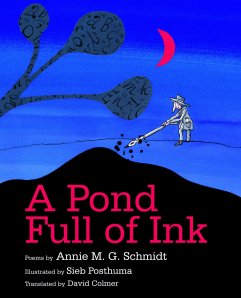 x
x
A Pond Full of Ink
Written by Anne M.G. Schmidt
Illustrated by Sieb Posthuma
Eerdmans Books for Young Readers 3/01/2014
978-0-8028-5433-9
Age 6 and up 34 pages
x
x
“Discover the humorous and imaginative world of Dutch writer Annie Schmidt with this new collection of her beloved poems. Paired for the first time with art from award-winning illustrator Sieb Posthuma, these poems offer readers of all ages a perfect introduction to the fresh and inventive voice of an international renowned author.”
Review
There are ten witty poems in A Pond Full of Ink. All are kid-friendly with subjects that will make most kids laugh. It begins with a situation most writers would love to have: a never-ending pond of ink and a portfolio of ten thousand stories and much more left to write. The writer might have written about the next poems subject: a naughty little girl who is not nice to anyone. She figures she will have enough time to be nice and polite once she becomes an adult.

With rhymes using some unusual words, these poems are quite delicious. Kids might need to look up a word or too, but it is good to learn new words while we read. In the poem Belinda Hated Getting Clean . . . Schmidt uses the word inveterate1 to describe how Belinda hated to get clean. Mom is at the end of her tether2 and tries to bathe her daughter, but Belinda glowers.3
In most of the poems, the new words can be deciphered by their context as in Three Elderly Otters who want to go boating but the signs all say,
“FORBIDDEN FOR OTTERS”
Those that keep the otters from the boats are called rotters.4 The three otters cannot find anything to do until they spot bicycles. Oh, so delighted, the three otters spot a sign that reads,
“OTTERS DON’T NEED TO PAY”

A Pond Full of Ink is a wonderful collection of poems. Each tells a story, most with unusual characters that the artist depicts at their quirkiest. Especially funny is Are You Joking, Mrs. Keller? Mr. Reeves is unhappy with the pets Mrs. Keller keeps in her house with her. He is not upset that there are seven. No, he is upset with the kind of pet she keeps. Mr. Reeves suddenly changes his mind after Mrs. Keller makes a veiled threat. What I really love is the illustrations. There are the seven bears standing in different windows. Each one is watching, some with an angry look. One pulls back the drapes, as if sneaking a peak. The one splash of bright color in the spread full of dark, muted reds and off-white is the green cactus sitting in an unoccupied window. Your eye is drawn to the cactus, but it is probably best to keep your eyes on the seven pet bears.
A Pond Full of Ink will entertain any age. The illustrations enhance the poems and are quite humorous. The poems are longer than most kid’s poetry, but they are easy to read aloud. Most are ridiculously unrealistic, like the table that wants to go for a stroll along the shore—and does! Also, a young girl’s (supposedly) stuffed crocodile eats nasty adults; a deer who wonders into a home ends up staying, sitting on the couch, used as a hanger for all sorts of the woman’s items; and a family living in a tree . . . wait, that could actually be true.
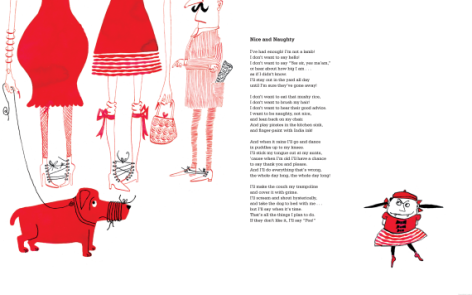
If you want to know read about a gossiped upon man who meets up with the four gossiping woman; three robbers who have robbed all but the moon and go after that; or any of the other poems described, you must read A Pond Full of Ink. The wonderful illustrations will help you visualize anything you cannot. Make sure you look around at the added details. The poems are funny, inventive, and some of the most interesting poems for kids I have read this year. A Pond Full of Ink comes from a poet from across the pond, Dutch poet Anne Schmidt. If you look closely, the book begins with “A” and ends with “Z” and a little sign that reads, “end.”
A POND FULL OF INK. Tex copyright © 1978 by The Estate of Annie M.G. Schmidt. Illustrations copyright © 2011 by Sieb Posthuma. English translation copyright © 2011 by David Colmer. Reproduced in part by permission of the publisher, Eerdmans BFYR, Grad Rapids, MI.
Purchase A Pond Full of Ink at Amazon —B&N—Book Depository—Eerdmans Books—your favorite bookstore.
—B&N—Book Depository—Eerdmans Books—your favorite bookstore.
Learn more about A Pond Full of Ink HERE
Meet the author, Annie M.G. Schmidt, at her website: http://www.annie-mg.com/
Meet the illustrator, Sieb Posthuma, at his website: http://www.siebposthuma.com/
Find more books at the Eerdmans BFYR website: http://www.eerdmans.com/
Eerdmans Books for Young Readers is an imprint of Wm. B. Eerdmans Publishing Company.
A Pond Full of Ink was first published in 2011 by Em Querido Uitgeverij B. V. The original title is Een vijver vol inkt.
x
1 firmly affixed, for a long time, in a bad habit—[inveterate]
2 rope, usually tied to an animal to keep it from roaming off—[tether]
3 a sullen, angry, resentful look on someone’s face–[glowers]
4 a nasty, unpleasant people—[rotters]
x

x
Copyright © 2014 by Sue Morris/Kid Lit Reviews
Filed under:
5stars,
Children's Books,
Library Donated Books,
Picture Book,
Poetry Tagged:
Anne M.G. Schmidt,
children's book reviews,
Eerdmans Books for Young Readers,
international poetry,
picsture books,
poetry,
Sieb Posthuma 







By:
Sue Morris,
on 7/7/2014
Blog:
Kid Lit Reviews
(
Login to Add to MyJacketFlap)
JacketFlap tags:
Children's Books,
Picture Book,
Favorites,
children's book reviews,
Middle Ages,
Eerdmans Books for Young Readers,
Debut Author,
S. D. Schindler,
parchment,
5stars,
Library Donated Books,
Wm. B. Eerdmans Publishing Company,
Benedictine monks,
Katy Beebe,
La Grande Chartreuse,
Add a tag
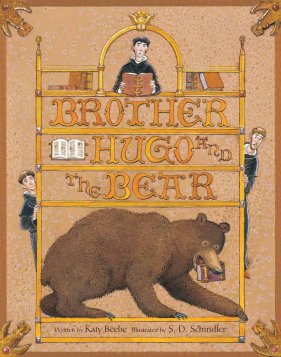 .
.
Brother Hugo and the Bear
Written by Katy Beebe
Illustrated by S. D. Schindler
Eerdmans’s Books for Young Readers 4/01/2014
978-0-8028-5407-0
Age 5 to 9 34 pages
.
“It befell that on the first day of Lent, Brother Hugo could not return his library book. The Abbot was most displeased. ‘Our house now lacks the comforting letters of St. Augustine, Brother Hugo. How did this happen?’ The precious book, it turns out, has been devoured by a bear, and so Hugo must replace it. Letter by letter and line by line the hapless monk crafts a new book, all the while being trailed by a hungry new friend who thinks that the words of St. Augustine are truly far sweeter than honey. Based loosely on a note found in a twelfth-century manuscript—and largely on the creative imaginings of the author—this humorous tale will surely delight readers who have acquired their own taste for books.”
Opening
“It befell that on the first day of Lent, Brother Hugo could not return his library book. ‘I shall have to inform the Abbot of this, Brother Hugo,’ said the librarian.”
Review
Poor Brother Hugo. A bear has eaten his library book, an important book for the monastery. To replace the book, Brother Hugo must first travel to a neighboring monastery and borrow their copy of St. Augustine. Throughout Lent, Brother Hugo must then copy this book, by hand, for his own monastery. Brother Hugo and the Bear is a beautiful book. The text looks similar to what one would find in an old religious tome, as do the illustrations. Each paragraph begins with a large letter entwined with grape vines and leaves. As for the bear, with those long claws it is no wonder Brother Hugo did nothing when the bear snatched St. Augustine from his hands.
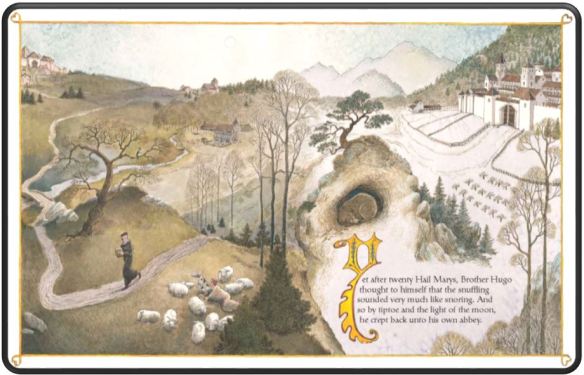
I like that all the monks help Brother Hugo prepare the things he needs to make the new book. It was not as easy as going to the stationary store, as it would be today.The monks had to make everything by hand. The illustrations show an offended goose walking away from the monks who now have a bird feather from which to fashion a pen. There is so much detail in Brother Hugo and the Bear one must take a second look after reading the story. I love illustrative detail and Brother Hugo and the Bear is loaded with details. I noticed a bear hiding behind the tree as Brother Hugo leaves the other monastery. Even the two dogs look in the direction of the tree and bark. Alas, that bear never follows Brother Hugo. (Maybe he is a scout for the book-eating bear.)
While Brother Hugo toils at his writing task, outside a noise begins to disturb the entire monastery.
“Brother Hugo, Brother Hugo,” the other monks cried, “what can be the meaning of that noise? It is like the rumbling of a great stomach or the whooshing of a fierce wind.”
The monks had the answer. It is the bear, hungry for another masterpiece. Once more, Brother Hugo’s friends help ensure the safe return of the original St. Augustine to the other monastery. On his return trip, Brother Hugo takes along a sack from his friends along with the original book. The contents of that sack should keep the bear at bay while Brother Hugo travels. The author uses the word “snuffling” to describe the noise made by the bear. I looked this up and found that the bear has a cold and is trying to breathe through a blocked nose. Poor Bear. I really like this word and hope kids take the time to look up its meaning.
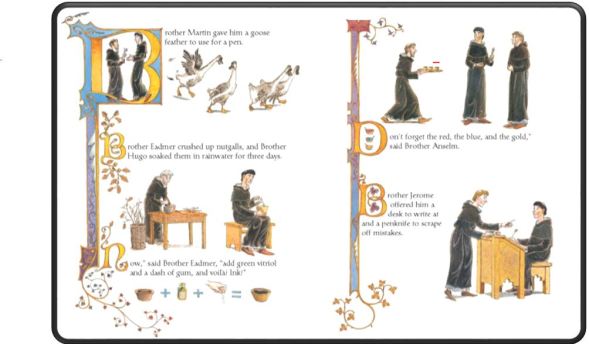
I was surprised to learn the story is based on a true event. There was actually a bear who ate a book in the middle ages. How interesting. The backmatter goes into detail as to how the author, first-time children’s author Katy Beebe, came up with the story. The illustrator also has a page of notes in which he compares his process to the process used by the monks. It is all very interesting. The best part of the book is the twist at the end. Almost to the door of the other monastery, the bear has caught up to the monk and waits. Brother Hugo has run out of offerings. What he does next will momentarily shock the bear. And here lies the twist, which is funny on many levels.
Children will enjoy Brother Hugo’s story. I think they will love the watercolor and ink illustrations, which are gorgeous. The friendship and cooperation displayed by the other monks is a wonderful message for children. Curious children will love learning of the work involved in producing a book. While the monks do this all by hand, the ingredients are the same: one author, several pages of paper, lots of ink, a copier to make many books, and the cover and binding. Brother Hugo is the copier of his time. All the monks were copiers. They copied books to keep the words available, you know, in case a bear eats the original book.
BROTHER HUGO AND THE BEAR. Text copyright © 214 by Katy Beebe. Illustrations copyright © 2014 by S. D. Schindler. Reproduced by permission of the publisher, Eerdmans Books for Young Readers.
Purchase Brother Hugo and the Bear at Amazon —B&N—Book Depository—Eerdmans—your local bookstore.
—B&N—Book Depository—Eerdmans—your local bookstore.
.
Learn more about Brother Hugo and the Bear HERE.
Meet the author, Katy Beebe, at her website: http://katybeebe.com/
Meet the illustrator, S. D. Schindler, at his website: http://sdschindlerbooks.com/
Find more books at Eerdmans Books for Young Readers website: http://www.eerdmans.com/youngreaders/
an Imprint of Wm. B. Eerdmans Publishing Company http://www.eerdmans.com/
.
Also NEW in 2014 by S.D. Schindler
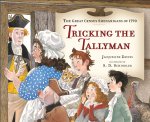
Tricking the Tallyman
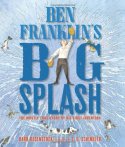
Ben Franklin’s Big Splash: The Mostly True Story of His First Invention
.
.

Filed under:
5stars,
Children's Books,
Debut Author,
Favorites,
Library Donated Books,
Picture Book Tagged:
Benedictine monks,
children's book reviews,
Eerdmans Books for Young Readers,
Katy Beebe,
La Grande Chartreuse,
Middle Ages,
parchment,
picture book,
S. D. Schindler,
Wm. B. Eerdmans Publishing Company 








By:
Jen Robinson,
on 5/29/2014
Blog:
Jen Robinson
(
Login to Add to MyJacketFlap)
JacketFlap tags:
Reviews,
picture book,
Picture Books,
Newsletter,
eerdmans books for young readers,
animal books,
bedtime book,
simona mulazzani,
giovanna zoboli,
Add a tag
Book: The Big Book of Slumber
Author: Giovanna Zoboli
Illustrator: Simona Mulazzani
Pages: 26
Age Range:3-6

 The Big Book of Slumber is as advertised. It's an over-size picture book sure to make any young listener feel cozily sleepy. Giovanna Zoboli's rhyming text, translated from Italian by Antony Shugaar, is soothing and full of whimsey, while Simona Mulazzani's detailed illustrations will reward repeat readings. The premise of The Big Book of Slumber is that a wide range of animals are going to sleep. Most of them are tucked into human-like beds, with blankets and pillows, though a few remain in their natural habitats. Like this:
The Big Book of Slumber is as advertised. It's an over-size picture book sure to make any young listener feel cozily sleepy. Giovanna Zoboli's rhyming text, translated from Italian by Antony Shugaar, is soothing and full of whimsey, while Simona Mulazzani's detailed illustrations will reward repeat readings. The premise of The Big Book of Slumber is that a wide range of animals are going to sleep. Most of them are tucked into human-like beds, with blankets and pillows, though a few remain in their natural habitats. Like this:
"Dolphin and tuna have turned out the light.
Nanny goat's tucking kids in for the night.
Rooster and hen are already sleeping --
so why are those baby chicks still up and cheeping?"
The page spread shows the dolphin and tuna underwater, eyes closed. A nanny goat tucks eight baby goats into separate beds, neatly lined up on a lawn. A chicken and rooster nod inside a hen house next door, while a dozen yellow chicks roam about the page.
On another page, several puppies are tucked into bed together, while two camels lie in bunk-beds, with "a moonlit oasis right over their heads",complete with sand and palm trees, right there on the top bunk. There is definitely a surreal feel to the book. But Mulazzani's illustrations are not fuzzy and dream-like, they are clearly defined, despite their quirky content.
This will be a fun book for kids, I think, with lots of animals, big and small, to look for on each page (most but not all referenced in the text). I found the text to be rhythmic without being sing-songy, positively calling out to be read aloud. As an adult, I prefer books that have more plot than this one (which is basically a series of collections of sleeping animals, no narrative). But I think that it will make my daughter laugh, while also helping her to calm down for sleep. And that's a winning combination. This one is going in our bedtime reading pile for sure.
Publisher: Eerdmans Books for Young Readers (@EBYR)
Publication Date: April 18 2014
Source of Book: Review copy from the publisher
FTC Required Disclosure:
This site is an Amazon affiliate, and purchases made through Amazon links (including linked book covers) may result in my receiving a small commission (at no additional cost to you).
© 2014 by Jennifer Robinson of Jen Robinson's Book Page. All rights reserved. You can also follow me @JensBookPage or at my Growing Bookworms page on Facebook.


By:
Betsy Bird,
on 5/22/2014
Blog:
A Fuse #8 Production
(
Login to Add to MyJacketFlap)
JacketFlap tags:
poetry,
Eerdmans Books for Young Readers,
picture book poetry,
Reviews 2014,
2014 reviews,
2014 poetry,
David Colmer,
Sieb Posthuma,
Annie M.G. Schmidt,
Reviews,
Add a tag
 A Pond Full of Ink
A Pond Full of Ink
By Annie M.G. Schmidt
Illustrated by Sieb Posthuma
Translated by David Colmer
Eerdmans Books for Young Readers
$16.00
ISBN: 978-0-8028-5433-9
Ages 7 and up
On shelves now
International children’s authors are great. They’re just not particularly well known in America. There are various reasons for this. Some of it has to do with the dearth of international children’s book importing. Bringing a book over sometimes requires translation, and there’s often little hope of the writer or illustrator touring if English isn’t a second language. Then add to this the fact that all the major children’s book awards in the U.S. have to go to American residents. Once in a while there’s an exception to these rules, of course. You’ll get a Shaun Tan or a Mem Fox (both Aussies, but you know what I mean). Generally, however, we dwell in ignorance and have to make an effort to know who else is out there in the world. Consider then the case of Annie M.G. Schmidt. If international children’s book authors are rarities on our fair shores, what are we to make of international children’s poets? Finding poetry for children here in the U.S. is a tricky enough proposition as it is. Add in the international element and it’s little surprise that Schmidt’s name rings few bells. Fortunately, our ignorance is our children’s gain. A Pond Full of Ink proves a charming collection of Schmidt’s work, translated expertly, original to its core.
“A fairy tale author I know / starts work every day when the roosters crow.” So begins the first poem in this collection of children’s poet Annie M.G. Schmidt. Twelve poems, judiciously edited, perfectly selected, are paired with the ribald art of illustrator Sieb Posthuma. Readers who flip through the pages will encounter everything from thieves that covet the moon to a teakettle with musical aspirations. The end result is a collection that is silly, subversive, and sly by turns.
 So what do we know about Annie M.G. Schmidt? Well, I looked about and heard at least one person refer to her as, “something like the Dutch Astrid Lindgren, [who] never broke through in the English-speaking world.” That would be translator David Colmer’s description. Looking her up I found various sites praising her, saying things like “almost everyone in the Netherlands is able to recite at least a line or two from one of her songs or poems. Her children’s books have become a national institution.” We might call her the Dutch Dr. Seuss then. As this is pretty much the only book of Ms. Schmidt’s that we have here in the U.S., A Pond Full of Ink has a lot of promise to fulfill. Fortunately, and as it just so happens, the book is charming. Akin to something along the lines of Shel Silverstein in terms of the unconnected ridiculous, Schmidt dwells on the silly and the thoughtful alike. Every person I know who has read this book has his or her own individual favorites. For my part, I was quite partial to “The Furniture”. Kids will pick their preferences. In fact, the book would actually be ideal for children’s book groups since each child would have their own personal faves.
So what do we know about Annie M.G. Schmidt? Well, I looked about and heard at least one person refer to her as, “something like the Dutch Astrid Lindgren, [who] never broke through in the English-speaking world.” That would be translator David Colmer’s description. Looking her up I found various sites praising her, saying things like “almost everyone in the Netherlands is able to recite at least a line or two from one of her songs or poems. Her children’s books have become a national institution.” We might call her the Dutch Dr. Seuss then. As this is pretty much the only book of Ms. Schmidt’s that we have here in the U.S., A Pond Full of Ink has a lot of promise to fulfill. Fortunately, and as it just so happens, the book is charming. Akin to something along the lines of Shel Silverstein in terms of the unconnected ridiculous, Schmidt dwells on the silly and the thoughtful alike. Every person I know who has read this book has his or her own individual favorites. For my part, I was quite partial to “The Furniture”. Kids will pick their preferences. In fact, the book would actually be ideal for children’s book groups since each child would have their own personal faves.
Just as I was unaware of the existence of Ms. Schmidt, so too was I unfamiliar with the art of Sieb Posthuma. Dutch too, Mr. Posthuma gives this book a distinct flavor entirely of his own. In fact, a little digging found that for this book Mr. Posthuma actually won the 2012 Gouden Penseel or Golden Paintbrush, the top prize for children’s books originally published in The Netherlands. One sees why. There’s a sly, clever quality to Posthuma’s art here. From the vampire fanged little girl of “Nice and Naughty” to bespectacled deer of “Aunty Jo” you can’t help but like these characters. Best of all, the book isn’t afraid to take a moment to just enjoy the art. There are several wordless two-page spreads that offer a quiet accompaniment to their preceding poems. Like the lush greenery of “Aunt Sue and Uncle Steve” or the blue and red vision of sea and land after “Three Elderly Otters”, Posthuma has been given the chance to muse.
 It’s not that I haven’t heard objections to the book. Some folks I’ve shown this too have questioned the translation, saying that only some poems really spoke to them. For my part, I think the translation keen. For one thing, David Colmer, the translator, had to translate rhyme. I just can’t even begin to imagine how hard that must be. Not only must the poems scan but rhyme as well? It’s at this point that one begins to wonder how the invisible hand of the translator plays into the text. With some digging I discovered that David Colmer is an Australian translator of Dutch literature based in Amsterdam. He seems to do particularly well when it comes to translating poetry and works for children. As a four-time winner of the David Reid Poetry Translation Prize, the man also appears to know what he is doing. I cannot even begin to fathom how one aligns scansion and rhyme in translation. All I can do is trust that Colmer does it well.
It’s not that I haven’t heard objections to the book. Some folks I’ve shown this too have questioned the translation, saying that only some poems really spoke to them. For my part, I think the translation keen. For one thing, David Colmer, the translator, had to translate rhyme. I just can’t even begin to imagine how hard that must be. Not only must the poems scan but rhyme as well? It’s at this point that one begins to wonder how the invisible hand of the translator plays into the text. With some digging I discovered that David Colmer is an Australian translator of Dutch literature based in Amsterdam. He seems to do particularly well when it comes to translating poetry and works for children. As a four-time winner of the David Reid Poetry Translation Prize, the man also appears to know what he is doing. I cannot even begin to fathom how one aligns scansion and rhyme in translation. All I can do is trust that Colmer does it well.
For my part, the only real objection I had to the book was the design. The poems are written in a typewriter-like font. No problems there. But occasionally the poems appear in large, unwieldy clumps. When integrated with the text, as they are with the poems “Three Elderly Otters” or “The Man Who Writes Fairy Tales” they can be lovely. But in cases like “Belinda Hated Getting Clean . . .” even adult readers will feel daunted when faced with a full page of tiny poetic type without so much as a break or an indentation to be seen. I don’t suppose there was much that could have been done about this when the book was translated for America, but it’s a pity just the same.
It is encouraging to think that though Ms. Schmidt was never brought to America in her lifetime, posthumously her words can fulfill their destiny decades after her death. A Pond Full of Ink does not attempt to be anything other than what it is. A short, smart selection of fun poems for kids of every age. A small clever treat, consider its loaded silliness for your own personal collection.
On shelves now.
Source: Advanced reading copy sent from publisher for review.
Like This? Then Try:
Other Blog Reviews: Children’s Illustration,
Professional Reviews:
Misc:
- So how did translator David Colmer tackle this book? Get the inside scoop here.
Videos:
A book trailer! Who would have thunk it?

By:
Sue Morris,
on 4/13/2014
Blog:
Kid Lit Reviews
(
Login to Add to MyJacketFlap)
JacketFlap tags:
Favorites,
children's book reviews,
growing up,
Eerdmans Books for Young Readers,
Mary Newell DePalma,
5stars,
Library Donated Books,
bird migration,
Eerdmans BfYR,
finding your way,
songbird migration,
songbirds,
Wm. B. Eerdmans Publishing Company,
Children's Books,
Picture Book,
Add a tag
 .
.
Two Little Birds
by Mary Newell DePalma
Eerdmans BfYR 2/14/2014
978-0-8028-5421-6
Age 4 to 8 32 pages
.
“Each little bird has a part in nature’s grand scheme: the earth tilts, the seasons change, and songbirds arrive in new places just as insects hatch, fruits ripen, and flowers bloom. In this story, two plucky young birds launch into their first journey, which proves to be full of challenge, peril, and wonder.”
Opening
“After much effort . . . two little birds emerge from their eggs.”
The Story
Two little birds enter the world and learn to do what little birds like them have always been doing: they eat, they play, and they grew up. Then, seeing a flock of birds heading south, the birds decide to join the journey. They flew farther than they ever had. Home was getting farther away and then a thunderstorm struck. The two little birds tumbled and lost their way. The flock is gone. The two little birds need to find their way to the flock or to home. Can they find their way?
Review
A simple story of nature that is more complex than one might think. The birds leave at night, when all songbirds leave for the migration south. The little birds want to go. Something in them must say it is time. They go, but find the flying is harder than they have ever done, but that they are stronger than they thought. The story of Two Little Birds is about two little song birds, yet, kids can find ways to relate to the little birds. It is time to change schools. The family has moved, or it is time for high school. The child’s confidence is less than normal. The situation is new and they wonder if they can make it in this new place, but then, they find that with a little hard work they can make it, just like the little birds. Relating this story to sports is far easier. A new team, will the child make it? A little harder to play at the newer level, but with some extra effort, a bit more hustle, and keeping their eye on the ball, the child fits in just fine, just like the little birds fit into their society.
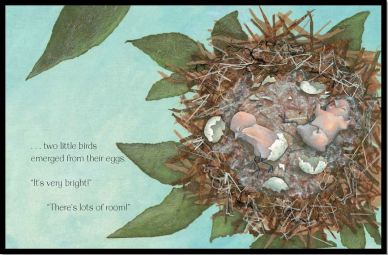
The story is also cute, one that young children will enjoy. The birds flew and flew and then tumbled. How many times do young kids tumble? Children will relate to the little birds, who muster on until they found their way, just like children bounce up and keep on going. [Not like an energizer bunny, but the analogy works.] Two Little Birds will make a very good story time or bedtime story, and is perfect for the kindergarten or preschool class.
The illustrations are wonderful. Mostly in blues and pastels, the author/illustrator used a mixed-media collage, which is most evident in the first and second spreads, where the birds lay upon the nest in their eggs or just hatched from them. Knowing this is a collage makes it easier to find those layers, such as the map of South Carolina as the birds tumble from the sky, thanks to lightning and thunder booms. Knowing the artist’s process, methods, or materials makes the illustrations more interesting.
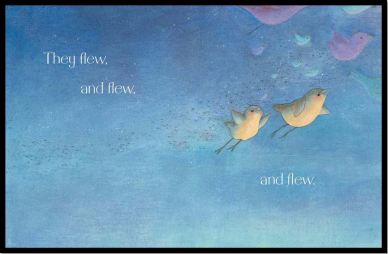
Young children will love the two little birds, who are unnamed—at least until the first reading. I imagine kids will have those two birds named in no time. The beautiful books will catch your eye with these two newborn birds leaving the nest. You can read Two Little Birds multiple times without any loss of enthusiasm, perfect for parents with young children who become hooked on one book for an undetermined amount of time. I hear that includes most every child, so it is a good thing the story is interesting and a nice read aloud.
After Two Little Birds, Ms. DePalma writes a little on the migration of songbirds. She explains that songbirds, orioles in particular, migrate at night from the north to the Yucatan Peninsula, which includes an 18-hour nonstop flight across the Gulf of Mexico. It is no wonder the two little birds became so tired. Your child and you do not need to make this flight to enjoy the migration. Simply read Two Little Birds.
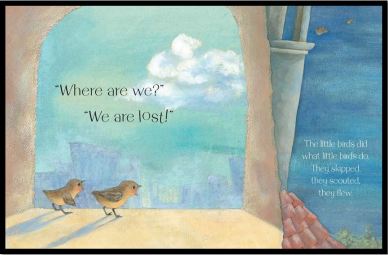
TWO LITTLE BIRDS. Text and illustrations copyright © 2014 by Mary Newell DePalma. Reproduced by permission of the publisher, Wm. B. Eerdmans Publishing Company, Grand Rapids, MI.
Learn more about Two Little Birds HERE.
Get your copy of Two Little Birds at Amazon—B&N—Eerdmans BfYR—your local bookstore.
.
Meet Mary Newell DePalma at her website: http://www.marynewelldepalma.com/
Find more books that are fascinating at Eerdmans BfYR website: http://www.eerdmans.com/YoungReaders/Default.aspx
Eerdmans Books for Young Readers is an imprint of Wm. B. Eerdmans Publishing Company.
.
Also by Mary Newell DePalma
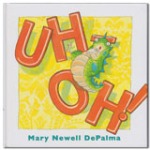
Uh-Oh!
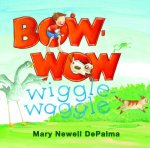
Bow-Wow Wiggle-Waggle
.
.
.
.
.
NEW at Eerdmans BfYR

Jesus
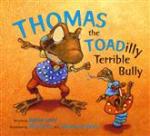
Thomas the Toadilly Terrible Bully
.
.

Filed under:
5stars,
Children's Books,
Favorites,
Library Donated Books,
Picture Book Tagged:
bird migration,
children's book reviews,
Eerdmans BfYR,
Eerdmans Books for Young Readers,
finding your way,
growing up,
Mary Newell DePalma,
songbird migration,
songbirds,
Wm. B. Eerdmans Publishing Company 







By:
KidLitReviews,
on 9/21/2013
Blog:
Kid Lit Reviews
(
Login to Add to MyJacketFlap)
JacketFlap tags:
Children's Books,
Chapter book,
middle children,
Birth order,
superheroes,
children's book reviews,
Eerdmans Books for Young Readers,
early reader,
4stars,
Library Donated Books,
Extraordinary Ernie,
Frances Watt,
Judy Watson,
Marvelous Maud,
Add a tag
. The Middle Sheep (Ernie and Maud) By Frances Watt Judy Watson, illustrator Eerdmans Books for Young Readers 4 Star . Back Cover: The Adventures of Extraordinary Ernie and Marvelous Maud continue . . . but what—or who—is making the usually cheerful and dependable Maud so grumpy? And why are she and Ernie arguing all …
By:
KidLitReviews,
on 9/16/2013
Blog:
Kid Lit Reviews
(
Login to Add to MyJacketFlap)
JacketFlap tags:
Children's Books,
mouse,
opposites,
cat,
Eerdmans Books for Young Readers,
perspectives,
4stars,
Library Donated Books,
Claudia Rueda,
William B. Eerdmans Publishing Company,
Add a tag
. Is It Big or Is It Little? by Claudia Rueda Eerdmans Books for Young Readers 4 Stars . Back Cover: To a mouse, nearly everything looks big—but to the cat that chases him, things look a bit different. Opening: Is it BIG? Or is it little? Is it DEEP? Or is it shallow? About …

By:
Betsy Bird,
on 5/2/2013
Blog:
A Fuse #8 Production
(
Login to Add to MyJacketFlap)
JacketFlap tags:
multicultural,
mysteries,
Reviews,
middle grade fiction,
historical fiction,
Best Books,
Eerdmans Books for Young Readers,
multicultural fiction,
middle grade mysteries,
middle grade historical fiction,
multicultural middle grade,
Best Books of 2013,
Reviews 2013,
2013 reviews,
2013 middle grade fiction,
2013 chapter books,
2013 historical fiction,
2013 mysteries,
Katie Quirk,
Add a tag
 A Girl Called Problem
A Girl Called Problem
By Katie Quirk
Eerdmans Books for Young Readers
$8.00
ISBN: 97800-8028-5404-9
Ages 9-12
On shelves now.
Who says that mystery novels for kids all have to include the same tropes and settings? I tell you, half the time when a kid comes up to a reference desk asking for a mystery they think what they want is the standard white kids in suburbia model perfected by Encyclopedia Brown and his ilk. They’re wrong. What they really want is great writing and a good mystery with a twist they don’t see coming. So I will hereby give grand kudos and heaping helpfuls of praise to the librarian/bookseller/parent who hears a kid ask for a mystery and hands them Katie Quirk’s A Girl Called Problem. This book is a trifecta of publishing rarities. A historical novel that is also a mystery set in a foreign country that just happens to be Tanzania. Trust me when I say your shelves aren’t exactly filled to brimming with such books. Would that they were, or at the very least, would that you had as many good books as this one. Smart commentary, an honestly interesting storyline, and sharp writing from start to finish, Quirk quickly establishes herself as one author to watch.
The thing about Shida is that in spite of her name (in Swahili it would be “problem”) you just can’t get her down. Sure, her mom is considered a witch, and every day she seems to make Shida’s life harder rather than easier. Still, Shida’s got dreams. She hopes to someday train to be a healer in her village of Litongo, and maybe even a village nurse. In light of all this, when the opportunity arises for all of Litongo to pick up and move to a new location, Shida’s on board with the plan. In Nija Panda she would be able to go to school and maybe even learn medicine firsthand. Her fellow villagers are wary but game. They seem to have more to gain than to lose from such a move. However, that’s before things start to go terribly wrong. Escaped cattle. Disease. Even death seems to await them in Nija Panda. Is the village truly cursed, just unlucky, or is there someone causing all these troubles? Someone who doesn’t want the people of Litongo there. Someone who will do anything at all to turn them back. It’s certainly possible and it’s up to Shida to figure out who the culprit might be.
The trouble with being an adult and reading a children’s work of mystery fiction is that too often the answer feels like it’s too obvious. Fortunately for me, I’m terrible at mysteries. I’ll swallow every last red herring and every false clue used by the author to lead me astray. So while at first it seems perfectly obvious who the bad guys would be, I confess that when the switcheroo took place I didn’t see it coming. It made perfect sense, of course, but I was as blindsided as our plucky heroine. I figure if I honestly as a 35-year-old adult can’t figure out the good guys from the bad in a book for kids, at least a significant chunk of child readers will be in the same boat.
Now I’ve a pet peeve regarding books set in Africa, particularly historical Africa, and I was keen to see whether or not Ms. Quirk would indulge it. You see, the story of a girl in a historical setting who wants to be a healer but can’t because of her gender is not a particularly new trope. We’ve seen it before, to a certain extent. What chaps my hide is when the author starts implying that tribal medicines and healing techniques are superstitious and outdated while modern medicine is significantly superior. Usually the heroine will fight against society’s prejudices, something will happen late in the game, and the villagers will see that she was right all along and that she’ll soon be able to use Western medicine to cure all ills. There’s something particularly galling about storylines of this sort, so imagine my surprise when I discovered that Quirk was not going to fall into that more than vaguely insulting mindset. Here is an author unafraid to pay some respect to the religion of the villagers. It never dismisses curses but acknowledges them alongside standard diseases. Example: “Though Shida was certain Furaha should take medicine for malaria, she was equally certain she should guard the spirit house that night. Parasites were responsible for some sicknesses and curses for others, and in this case, they needed to protect against both.”
Quirk is also quite adept at using the middle grade chapter book format to tackle some pretty complex issues. To an adult reading this book it might be clear that Shida’s mother suffers from a severe form of depression. There’s no way the village would be prepared to handle this diagnosis, and Shida herself just grows angry with the woman who stays inside all the time. You could get a very interesting book discussion going with child readers about whether or not Shida should really blame her mother as vehemently as she does. On the one hand, you can see her point. On the other, her mother is clearly in pain. Similarly well done is the final discussion of witches. Quirk brings up a very sophisticated conversation wherein Shida comes to understand that accused witches are very often widows who must work to keep themselves alive and that, through these efforts, acquire supposedly witchy attributes. Quirk never hits you over the head with these thoughts. She just lets her heroine’s assumptions fall in the face of close and careful observation.
All this could be true, but without caring about the characters it wouldn’t be worth much. I think part of the reason I like the book as much as I do is that everyone has three dimensions (with the occasional rare exception). Even the revealed villain turns out to have a backstory that explains their impetus, though it doesn’t excuse their actions. As for Shida herself, she may be positive but she’s no Pollyanna. Depression hits her hard sometimes too, but through it all she uses her brain. Because she is able to apply what she learns in school to the real world, she’s capable of following the clues and tracking down the real culprit behind everyone’s troubles. Passive protagonists have no place in A Girl Called Problem. No place at all.
Finally, in an era of Common Core Standards I cannot help but notice how much a kid can learn about Tanzania from this book. Historical Tanzania at that! A Glossary at the back does a very good job of explaining everything from flamboyant trees to n’gombe to President Julius Nyerere’s plan for Tanzania. There are also photographs mixed into the Glossary that do a good job of giving a contemporary spin on a historical work.
Windows and mirrors. That’s the phrase used by children’s literature professionals to explain what we look for in books for kids. We want them to have books that reflect their own experiences and observations (mirrors) and we also want them to have books that reflect the experiences and observations of kids living in very different circumstances (windows). Mirror books can be a lot easier to recommend to kids than window books, but that just means you need to try harder. So next time a 9-12 year-old comes to you begging for a mystery, upset their expectations. Hand them A Girl Called Problem and bet them they won’t be able to guess the bad guy. In the process, you might just be able to introduce that kid to their latest favorite book.
On shelves now.
Source: Galley sent from publisher for review.
Like This? Then Try:
Notes on the Cover: Now was that so hard? We ask and we ask and we ask for brown faces on our middle grade fiction and still it feels like pulling teeth to get it done. Eerdmans really blew this one out of the water, and it seems they spared no expense. The book jacket is the brainchild of Richard Tuschman who you may know better as the man behind the cover of Claire Vanderpool’s Newbery Award winning Moon Over Manifest. Beautiful.
Other Blog Reviews: Loganberryblog
Professional Reviews: A star from Kirkus
Misc:
- This is utterly fascinating. In this post author Katie Quirk talks about the process that led to the current (and truly lovely) cover.
- And Ms. Quirk shares what a typical day for Shida might look like in this video.







By:
Betsy Bird,
on 11/6/2012
Blog:
A Fuse #8 Production
(
Login to Add to MyJacketFlap)
JacketFlap tags:
2012 reviews,
Best Books of 2012,
2012 biographies,
2012 nonfiction,
2012 picture book biographies,
2012 nonfiction picture books,
nonfiction,
nonfiction picture books,
biographies,
Eerdmans Books for Young Readers,
Michelle Markel,
picture book biographies,
Uncategorized,
Amanda Hall,
2012 Sibert Award contender,
Add a tag
 The Fantastic Jungles of Henri Rousseau
The Fantastic Jungles of Henri Rousseau
By Michelle Markel
Illustrated by Amanda Hall
Eerdmans Books for Young Readers
$17.00
ISBN: 978-0-8028-5264-6
Ages 4-8
On shelves now
I’m not ashamed to say it, though perhaps I should be. Still, it’s true. Though I grew up in the middle class with a good education and a stint at a liberal arts college there are huge gaping gaps in my knowledge that have consistently been filled in over the years by children’s books. I know that I am not alone in this. When I worked in NYPL’s Central Children’s Room we had any number of regular adult patrons that would come in seeking children’s books on a variety of different topics so that they could learn about them in a non-threatening fashion. At its best a children’s book takes a complex subject and synthesizes it down to its most essential parts. Simple enough. But if you’re dealing with a picture book biography, it then has to turn a human life in a cohesive (child friendly) story. No mean feat. So when I saw this picture book bio of the artist Henri Rousseau I was immediately arrested by its art. Then I sort of came to realize that when it came to the man himself, I knew nothing. Next to nothing. I may never win a Jeopardy round or a game of Trivial Pursuit but thanks to great books like this one I may someday attain the education of a seven-year-old. There are worse fates in the world. These days, seven-year-olds get all the good stuff.
Your everyday average forty-year-old toll collector doesn’t usually drop everything to become a painter, yet that’s exactly what one did back in the 19th century. His name was Henri Rousseau and though he never took an art course in his life (art lessons aren’t exactly available on a toll collector’s budget) he does his research, looks at art, sits himself down, and begins to paint. He’s incredibly excited after his first big exhibition but his reviews say mostly “mean things” about his art. Still, he clips them, saves them, and continues to paint. Over the years he meets with very little success but is inspired by greenhouses and the lush topiary found inside. He can’t afford to ever see a jungle of his own so he makes them up. Finally, after decades and decades, the new young crop of artists takes note of his work. At last, he is celebrated and appreciated and his naïf style is seen for what it truly is; Simultaneously ahead of its time, and timeless.
 As far as I can tell the picture book biography can go in a certain number of directions when it comes to its interior art. It can seek to emulate the original artist, mimicking their style with mixed results. Or it can eschew the original artist altogether and only show their paintings as images on walls or in the notes at the book’s end. Artist Amanda Hall takes a slightly different take with her art, inserting Mr. Rousseau into his own works. As she says at the end “Instead of my usual pencil crayon and watercolor technique, I used both watercolor and acrylics for the illustrations, as I wanted to get close to the feel of Rousseau’s own paintings. I decided to break the rules of scale and perspective to reflect his unusual way of seeing the world. For some of the illustrations I drew directly on his actual paintings, altering them playfully to help tell the story.” That right there might be the book’s difference. I think that for many of us, the joy of an Henri Rousseau painting lies not in the composition necessarily (though that is a plus) but the sheer feel of the piece. Rousseau’s jungle scenes do not look or feel like anyone else’s and Hall has done a stellar job capturing, if not the exact feel, then a winning replica of it for kids. The endpapers of this book are particularly telling. Open the cover and there you find all the usual suspects in a Rousseau landscape, each one creeping and peeking out at you from behind the ferns and oversized blossoms.
As far as I can tell the picture book biography can go in a certain number of directions when it comes to its interior art. It can seek to emulate the original artist, mimicking their style with mixed results. Or it can eschew the original artist altogether and only show their paintings as images on walls or in the notes at the book’s end. Artist Amanda Hall takes a slightly different take with her art, inserting Mr. Rousseau into his own works. As she says at the end “Instead of my usual pencil crayon and watercolor technique, I used both watercolor and acrylics for the illustrations, as I wanted to get close to the feel of Rousseau’s own paintings. I decided to break the rules of scale and perspective to reflect his unusual way of seeing the world. For some of the illustrations I drew directly on his actual paintings, altering them playfully to help tell the story.” That right there might be the book’s difference. I think that for many of us, the joy of an Henri Rousseau painting lies not in the composition necessarily (though that is a plus) but the sheer feel of the piece. Rousseau’s jungle scenes do not look or feel like anyone else’s and Hall has done a stellar job capturing, if not the exact feel, then a winning replica of it for kids. The endpapers of this book are particularly telling. Open the cover and there you find all the usual suspects in a Rousseau landscape, each one creeping and peeking out at you from behind the ferns and oversized blossoms.
A poorly made picture book bio will lay out its pictures in a straightforward dull-as-dishwater manner never deviating or even attempting to inject so much as an artistic whim. The interesting thing about Hall’s take on Rousseau is that while, yes, she plays around with scale and perspective willy-nilly, she also injects a fair amount of whimsy. Not just the usual artist-flying-through-the-air-to-represent-his-mental-journey type of stuff either. There is a moment early on when a tiny Rousseau pulling a handcart approaches gargantuan figures that look down upon him with a mixture of pop-eyed surprise and, in some cases, anger. Amongst them, wearing the coat and tails of gentlemen, are two dogs and one gorilla. Later Hall indicates the passing of the years by featuring three portraits of Rousseau, hair growing grey, beard cut down to a jaunty mustache. On the opposite page three critics perch on mountains, smirking behind their hands or just gaping in general. It’s the weirdness that sets this book apart and makes it better than much of its ilk. It’s refreshing to encounter a bio that isn’t afraid to make things odd if it has to. And for some reason that I just can’t define . . . it definitely has to.
 But to get back a bit to the types of bios out there for kids, as I mentioned before Hall inserts Rousseau directly into his own painting when we look at his life. Done poorly this would give the impression that he actually did live in jungles or traipse about with lions, and I’m sure there will be the occasional young reader who will need some clarification on that point. But in terms of teaching the book, Hall has handed teachers a marvelous tool. You could spend quite a lot of time flipping between the paintings here and the ones Rousseau actually created. Kids could spot the differences, the similarities, and get a good sense of how one inspired the other. Near the end of the book Hall also slips in a number of cameos from contemporary artists, and even goes so far as to include a key identifying those individuals on the last few pages. Imagine how rich an artistic unit would be if a teacher were to take that key and pair it with the author bios of THOSE people as well. For Gertrude Stein just pull out Gertrude is Gertrude is Gertrude is Gertrude by Jonah Winter. Pablo Picasso? A quick look at The Boy Who Bit Picasso by Antony Penrose. Lucky kids.
But to get back a bit to the types of bios out there for kids, as I mentioned before Hall inserts Rousseau directly into his own painting when we look at his life. Done poorly this would give the impression that he actually did live in jungles or traipse about with lions, and I’m sure there will be the occasional young reader who will need some clarification on that point. But in terms of teaching the book, Hall has handed teachers a marvelous tool. You could spend quite a lot of time flipping between the paintings here and the ones Rousseau actually created. Kids could spot the differences, the similarities, and get a good sense of how one inspired the other. Near the end of the book Hall also slips in a number of cameos from contemporary artists, and even goes so far as to include a key identifying those individuals on the last few pages. Imagine how rich an artistic unit would be if a teacher were to take that key and pair it with the author bios of THOSE people as well. For Gertrude Stein just pull out Gertrude is Gertrude is Gertrude is Gertrude by Jonah Winter. Pablo Picasso? A quick look at The Boy Who Bit Picasso by Antony Penrose. Lucky kids.
Just as the art of a picture book biography can go any number of directions, the storytelling is in the same boat. You want to tell the life of a man. Fair enough. Do you encompass everything from birth to death, marking dates and important places along the way? Do you synthesize that life down to a single moment and then use your Author’s Note at the end to tell why that person is important at all (many is the Author’s Note forced to do the heavy lifting). Or do you just zero in on what it is that made that person famous in the first place and look at how they struggled with their gift? Author Michelle Markel opts for the latter. A former journalist, Markel first cut her teeth on the author bio with her lovely Dreamer from the Village: The Story of Marc Chagall. Finding that these stories of outsider artists appealed to her, the move to Rousseau was a natural one. One that focuses on the man’s attempts to become an artist in the face of constant, near unending critical distaste. Markel’s gift here is that she is telling the story of someone overcoming the odds (to a certain extent . . . I mean he still died a pauper an all) in the face of folks telling him what he could or couldn’t do. It’s inspirational but on a very gentle scale. You’re not being forced to hear a sermon on the joys of stick-to-itativeness. She lands the ending too, effortlessly transitioning from his first successful debut at an exhibition to how he is remembered today.
I remember having to learn about artists and composers in elementary school and how strange and dull they all seemed. Just a list of dead white men that didn’t have anything to do with my life or me. The best picture book bios seek to correct that old method of teaching. To make their subjects not merely “come alive” as the saying goes but turn into flesh and blood people. You learn best about a person when that person isn’t perfect, has troubles, and yet has some spark, some inescapable something about them that attracts notice. A combination of smart writing and smarter art is ideal, particularly when you’re dealing with picture book biographies. And The Fantastic Jungles of Henri Rousseau is nothing if not smart. It typifies the kind of bios I hope we see more of in the future. And, with any luck, it will help to create the kinds of people I’d like to see more of in the future. People like Henri Rousseau. Whatta fella. Whatta book.
On shelves now.
Source: Final copy sent from publisher for review.
Like This? Then Try:
Other Blog Reviews:
Professional Reviews: Kirkus
Interviews: With Michelle Markel at I.N.K. (Interesting Nonfiction for Kids)
Misc: Read what Ms. Markel has to say about the book herself when she writes the guest post at Cynsations.
Videos:
A nice little book trailer exists as well.
There’s even a director’s cut.

By:
Betsy Bird,
on 3/1/2012
Blog:
A Fuse #8 Production
(
Login to Add to MyJacketFlap)
JacketFlap tags:
Uncategorized,
Eerdmans Books for Young Readers,
translations,
children's literature in translation,
2012 picture books,
2012 reviews,
2012 translated children's books,
Don Bartlett,
Henrik Hovland,
Norwegian children's books,
Torill Kove,
translated picture books,
Add a tag
 John Jensen Feels Different
John Jensen Feels Different
By Henrik Hovland
Illustrated by Torill Kove
Translated by Don Bartlett
Eerdmans Books for Young Readers
$16.00
ISBN: 978-0-8028-5399-8
For ages 4-8
On shelves now
There is a lot to be said for a picture book book that is so unapologetically Norwegian that it ends up making you completely (not to mention unexpectedly) love it, regionalism and all. If you’ve ever encountered a large quantity of picture books from countries other than your own then you’ll know that tone is everything. Books in America tend to a have a distinctive flavor while books from other nations have another. Sometimes (often?) the two flavors don’t mix but once in a great while you end up with something like John Jensen Feels Different and everything’s okay again. A recent import, the book tackles the familiar theme of it’s-okay-to-be-different and gives it a bit of a twist. Understated and sly it’s a unique kind of book about a unique kind of guy. Funny and unfamiliar all at once, this is one case where the packaging matches the product.
John Jensen. He feels different. He feels it at home, on the bus, and at work. As we watch this perfectly amiable alligator (crocodile?) navigates through the realistic world of humans, holding down a good job as a tax consultant, we see him struggle with the idea. After much thought John decides that it’s his tail that makes him so very different from other people. Yet an attempt to tape it to his body only turns to pain when he sprains it after an accident. At the hospital he makes the acquaintance of Dr. Field (a nice elephant) who gives John the inspiring words he needs to stop being silly about his tail/who he is and to get on with his life.
I love the deadpan humor of it all. In fact the visual gags are such a perfect complement to the text that I was surprised to find that the author and illustrator weren’t one and the same. They must have consulted with one another heavily when creating the book. For example, I loved how artist Torill Kove portrayed John as a slightly sheepish reptilian office mate. There’s a great moment when he looks at a picture of fellow alligators, all of whom are his identical match, and he thinks, “Maybe I was adopted” followed by the book’s comment that “He doesn’t seem to look like anyone else in his family.” There were other little sly moments as well. I love that Dr. Field wears red sneakers. And I thought the endpapers were particularly keen. At the front of the book is the beginning of John tying his customary red bow tie and at the back is the rest of the process. It’s practically step by step.
 Then there’s the story itself. This is one of those books where the child readers squeal in frustration at the hero’s seeming stupidity. As John tries to figure out why exactly he’s different you can practically channel the voices of five-year-olds across the globe that scream, “He’s an alligator!!!” Of course, by not mentioning that John is an alligator (or is he a crocodile?) the book becomes an easy metaphor. By the way, the translation of the book is by one Don Bartlett. Let
Then there’s the story itself. This is one of those books where the child readers squeal in frustration at the hero’s seeming stupidity. As John tries to figure out why exactly he’s different you can practically channel the voices of five-year-olds across the globe that scream, “He’s an alligator!!!” Of course, by not mentioning that John is an alligator (or is he a crocodile?) the book becomes an easy metaphor. By the way, the translation of the book is by one Don Bartlett. Let
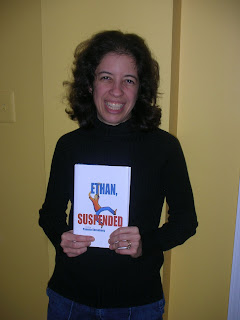 Pamela Ehrenberg is the author of ETHAN SUSPENDED, a multi-layered novel about a boy who moves into the home of his grandparents. ETHAN SUSPENDED is a wonderful example of a growing genre in Jewish kidlit, with a strong Jewish character in a story that will appeal to kids of all backgrounds. Pamela is a former teacher. She currently lives in Washington, DC, with her husband and young daughter. I’m so happy to welcome Pamela and share her thoughts about writing.
Pamela Ehrenberg is the author of ETHAN SUSPENDED, a multi-layered novel about a boy who moves into the home of his grandparents. ETHAN SUSPENDED is a wonderful example of a growing genre in Jewish kidlit, with a strong Jewish character in a story that will appeal to kids of all backgrounds. Pamela is a former teacher. She currently lives in Washington, DC, with her husband and young daughter. I’m so happy to welcome Pamela and share her thoughts about writing.
Tell me a little bit about your latest book. Why were you drawn to write about a Jewish theme or character?
Ethan, Suspended (Eerdmans Books for Young Readers) was published in March 2007; it's about a kid who moves to Washington, DC, to live with his grandparents and becomes the only white, and Jewish, student at his junior high school. He also becomes the world's first jazz oboist.
I don't think I consciously chose to write about Jewish characters; it was more like as they talked (and ate) I realized that of course they were Jewish. Exploring the history of Ethan's family in DC, and why his grandparents stayed put as their friends moved out to the suburbs, made me want to learn about Jewish roles during the Civil Rights Movement and past and present relationships between Jewish and African-American communities.
What type of research was involved?
Mostly it was the first-hand experience of teaching in a DC junior high. The school Ethan attends is fictional, but the setting was inspired by a school where I taught seventh and eighth-grade English a few years ago. As I was writing, I found gaps in my knowledge that led me to do some research at the DC Historical Society and the Martin Luther King, Jr. Memorial Library (the stairwell of which appears in the book itself, as the site of the novel's one kiss). I also researched a few questions online, such as when I needed to know what flavors Fruit-by-the-Foot comes in.
How did you become a children's writer?
I think I've always been one: I remember "writing" a story in kindergarten and being dismayed when the ending was misinterpreted by one of my classmates. That was when I first thought about the relationship between writer and reader, how what I put on the page doesn't matter nearly as much as what the reader thinks is there. As an English major in college, I spent a couple of years trying to write "literary" short stories, until a professor returned a draft to me with the note, "This sounds like the first chapter of a young people's novel." That comment freed me to write what I had always loved.
What are you working on now?
I'm working on edits for my new book, currently called "Tillman County Fire," which is due out from Eerdmans in late 2008 or early 2009. It's about a fire that takes place in a rural West Virginia community--one of the main characters is one-quarter Jewish (through his father), so we'll see whether it's ultimately considered "Jewish book." And I'm also working on a new novel, about a Jewish extended family in 1950s Baltimore.
A few fun facts about me:
I live in Washington, D.C., with my husband Eric and daughter Talia (age 2.5 as of this writing). Neighborhood favorites include Butterscotch and Brownie, the gerbils in the kids' area of our library; a phenomenal Tot Shabbat service; and a couple of really nice coffee shops for writing. This year we came off the waiting list for a plot in our community garden, and Talia and I successfully grew 11 tomatoes and more kale than any of us had thought possible. More fun facts about me are on my website, www.pamelaehrenberg.com.
My favorite holiday:
Passover. I love the seders, especially our wildly off-key versions of adapted classics (in my family, "Adir Bimlicha" became "Grebow of Pimlico" in honor of my late grandfather's insurance business) and new favorites like "Don't Sit on the Afikomen." I love re-discovering treasures like the frog dish for holding saltwater (a gift from the rabbi who married us) and the plastic clapping hands that, after enough wine, sound vaguely like hail. But mostly I love how everything feels different for a week when our foods and dishes are different. I think a good book can have a similar effect, making the familiar seem just a little bit unfamiliar, making me see the world a little bit differently.
Pamela, thanks for sharing your thoughts! I promise to forward requests for the lyrics to “Don’t sit on the Afikomen!”
To learn more about ETHAN SUSPENDED, please visit Pamela’s website: www.pamelaehrenberg.com

By: Kirsty,
on 6/21/2007
Blog:
OUPblog
(
Login to Add to MyJacketFlap)
JacketFlap tags:
music,
boy,
UK,
Current Events,
oxford,
madonna,
george,
studio,
A-Featured,
oup,
press,
beatles,
university,
ball,
corby,
casino,
sixties,
adam,
ant,
54,
Add a tag

By Kirsty OUP-UK
Saturday 16 June 2007 saw the Oxford offices of OUP transformed for one night only: the Oxford University Press Ball. These momentous nights only take place every few years, so it really is a special occasion. Below, for your viewing pleasure, are some photographs from the night in question. (more…)
Share This
 The Amazing Age of John Roy Lynch
The Amazing Age of John Roy Lynch How do you write a book for children about a time when things were starting to look good and then plummeted into bad for a very very long time? I think kids have this perception (oh heck, a bunch of adults too) that we live in the best of all possible worlds. For example, there’s a children’s book series called Infinity Ring where the basic premise is that bad guys have gone and changed history and now it’s up to our heroes to put everything back because, obviously, this world we live in right now is the best. Simple, right? Their first adventure is to make sure Columbus “discovers” America so . . . yup. Too often books for kids reinforce the belief that everything that has happened has to have happened that way. So when we consider how few books really discuss Reconstruction, it’s not exactly surprising. Children’s books are distinguished, in part, by their capacity to inspire hope. What is there about Reconstruction to cause hope at all? And how do you teach that to kids?
How do you write a book for children about a time when things were starting to look good and then plummeted into bad for a very very long time? I think kids have this perception (oh heck, a bunch of adults too) that we live in the best of all possible worlds. For example, there’s a children’s book series called Infinity Ring where the basic premise is that bad guys have gone and changed history and now it’s up to our heroes to put everything back because, obviously, this world we live in right now is the best. Simple, right? Their first adventure is to make sure Columbus “discovers” America so . . . yup. Too often books for kids reinforce the belief that everything that has happened has to have happened that way. So when we consider how few books really discuss Reconstruction, it’s not exactly surprising. Children’s books are distinguished, in part, by their capacity to inspire hope. What is there about Reconstruction to cause hope at all? And how do you teach that to kids? And he plays fair. These days I read nonfiction picture books with my teeth clenched. Why? Because I’ve started holding them to high standards (doggone it). And there are so many moments in this book that could have been done incorrectly. Heck, the first image you see when you open it up is of John Roy Lynch’s family, his white overseer father holding his black wife tenderly as their kids stand by. I saw it and immediately wondered how we could believe that Lynch’s parents ever cared for one another. Yet a turn of the page and Barton not only puts Patrick Lynch’s profession into context (“while he may have loved these slaves, he most likely took the whip to others”) but provides information on how he attempted to buy his wife and children. Later there is some dialogue in the book, as when Lynch’s owner at one point joshes with him at the table and John Roy makes the mistake of offering an honest answer. Yet the dialogue is clearly taken from a text somewhere, not made up to fit the context of the book. I loathe faux dialogue, mostly because it’s entirely unnecessary. Barton shows clearly that one need never rely upon it to make a book exemplary.
And he plays fair. These days I read nonfiction picture books with my teeth clenched. Why? Because I’ve started holding them to high standards (doggone it). And there are so many moments in this book that could have been done incorrectly. Heck, the first image you see when you open it up is of John Roy Lynch’s family, his white overseer father holding his black wife tenderly as their kids stand by. I saw it and immediately wondered how we could believe that Lynch’s parents ever cared for one another. Yet a turn of the page and Barton not only puts Patrick Lynch’s profession into context (“while he may have loved these slaves, he most likely took the whip to others”) but provides information on how he attempted to buy his wife and children. Later there is some dialogue in the book, as when Lynch’s owner at one point joshes with him at the table and John Roy makes the mistake of offering an honest answer. Yet the dialogue is clearly taken from a text somewhere, not made up to fit the context of the book. I loathe faux dialogue, mostly because it’s entirely unnecessary. Barton shows clearly that one need never rely upon it to make a book exemplary. It’s not shown as an exact moment in time, but rather a composite of events that would have happened then. And there’s something about Tate’s style that makes it manageable. The whip has not yet fallen and the noose has not yet been placed around a neck, but the angry mobs are there and you know that the worst is imminent. Most interesting to me too is that far in the background a white woman and her two children just stand there, neither approving nor condemning the action. I think you could get a very good conversation out of kids about this family. What are they feeling? Whose side are they on? Why don’t they do something?
It’s not shown as an exact moment in time, but rather a composite of events that would have happened then. And there’s something about Tate’s style that makes it manageable. The whip has not yet fallen and the noose has not yet been placed around a neck, but the angry mobs are there and you know that the worst is imminent. Most interesting to me too is that far in the background a white woman and her two children just stand there, neither approving nor condemning the action. I think you could get a very good conversation out of kids about this family. What are they feeling? Whose side are they on? Why don’t they do something?



































Thank you, Betsy! Sharp-eyed readers will notice the tiny little “chicken for a dime” in the book trailer. Of all the details that Don captured, that one is my favorite.
I noticed it in the book too! It made me inordinately happy to see.
I am a fan of both Don and Chris’ work. After reading your review and watching the video, The Amazing Age of John Roy Lynch has moved to the top of my book list.
Chris Barton is rapidly becoming one of my fave nonfiction people – I want to emulate that know-how with research, and that ease of imparting it in a way that’s just… sitting on the front porch, spinning a yarn – the laden-with-facts bit of it just feels so effortless! And, WOW, Bets, that you noticed that the character had a blank face in the presence of white folk… you have sharp eyes, and Don Tate is a super-sharp artist. Thanks especially for breaking down your thoughts on the artwork. The hyperrealism – I never knew what to call it before, really – is sometimes hard for me to take, much less a child; it’s almost… ugly, in a way. I think this artwork supports a fantastic story of The Reconstruction era, and makes it enticing…
“Enticing” and “The Reconstruction era” in the same sentence is kind of surreal, isn’t it?! Kudos and well done to the author and illustrator!
[…] of books I want to read: The Amazing Age of Judge Roy Lynch by Chris Barton, reviewed at Fuse #8. The Hired Girl by Laura Amy Schlitz, reviewed by Abby the Librarian. 7 Women and the Secret of […]
[…] Elizabeth Bird, librarian extraordinaire, had a lot to say this week about The Amazing Age of John Roy Lynch on her School Library Journal blog. […]